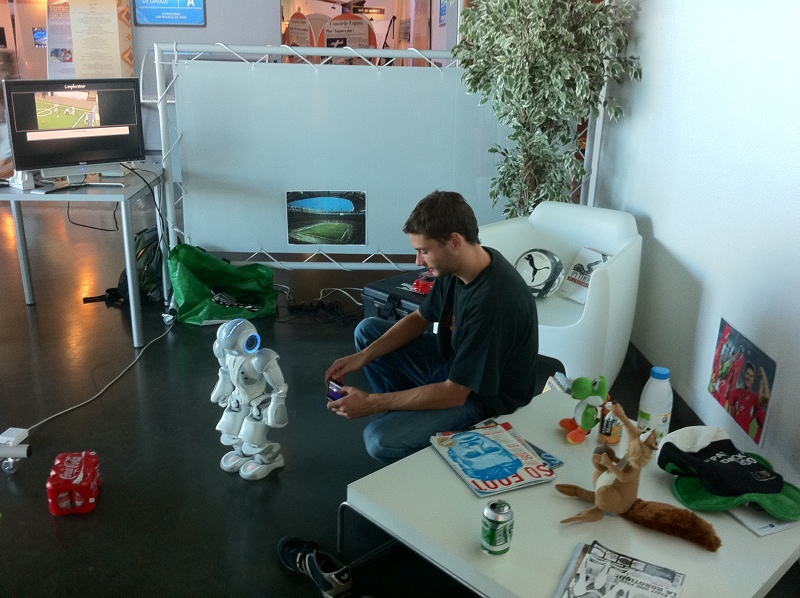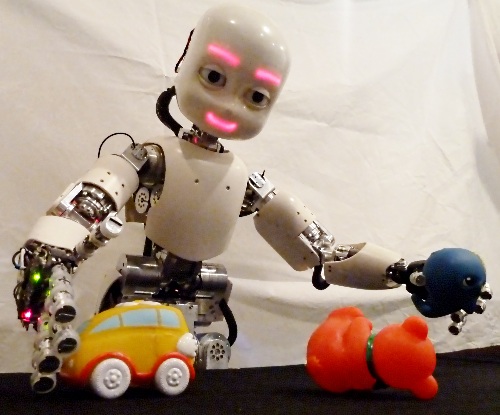Section: New Results
Autonomous and Social Perceptual Learning
The Impact of Human-Robot Interfaces on the Learning of Visual Objects
Participants : Pierre Rouanet, Pierre-Yves Oudeyer, Fabien Danieau, David Filliat.
We have continued and finalized a large-scale study of the impact of interfaces allowing non-expert users to efficiently and intuitively teach a robot to recognize new visual objects. We identified challenges that need to be addressed for real-world deployment of robots capable of learning new visual objects in interaction with everyday users. We argue that in addition to robust machine learning and computer vision methods, well-designed interfaces are crucial for learning efficiency. In particular, we argue that interfaces can be key in helping non-expert users to collect good learning examples and thus improve the performance of the overall learning system. Then, we have designed four alternative human-robot interfaces: three are based on the use of a mediating artifact (smartphone, wiimote, wiimote and laser), and one is based on natural human gestures (with a Wizard-of-Oz recognition system). These interfaces mainly vary in the kind of feedback provided to the user, allowing him to understand more or less easily what the robot is perceiving, and thus guide his way of providing training examples differently. We then evaluated the impact of these interfaces, in terms of learning efficiency, usability and user's experience, through a real world and large scale user study. In this experiment, we asked participants to teach a robot twelve different new visual objects in the context of a robotic game. This game happens in a home-like environment and was designed to motivate and engage users in an interaction where using the system was meaningful. We then analyzed results that show significant differences among interfaces. In particular, we showed that interfaces such as the smartphone interface allows non-expert users to intuitively provide much better training examples to the robot, almost as good as expert users who are trained for this task and aware of the different visual perception and machine learning issues. We also showed that artifact-mediated teaching is significantly more efficient for robot learning, and equally good in terms of usability and user's experience, than teaching thanks to a gesture-based human-like interaction.
This work was published in the IEEE Transactions on Robotics [34] .
|
|
|
|
Developmental object learning through manipulation and human demonstration
Participants : Natalia Lyubova, David Filliat.
The goal of this work is to design a visual system for a humanoid robot. We used a developmental approach that allows a humanoid robot to continuously and incrementally learn entities through interaction with a human partner in a first stage before categorizing these entities into objects, humans or robot parts and using this knowledge to improve objects models by manipulation in a second stage. This approach does not require prior knowledge about the appearance of the robot, the human or the objects. The proposed perceptual system segments the visual space into proto-objects, analyses their appearance, and associates them with physical entities. Entities are then classified based on the mutual information with proprioception and on motion statistics. The ability to discriminate between the robot’s parts and a manipulated object then allows to update the object model with newly observed object views during manipulation. We evaluate our system on an iCub robot, showing the independence of the self-identification method on the robot’s hands appearances by wearing different colored gloves. The interactive object learning using self-identification shows an improvement in the objects recognition accuracy with respect to learning through observation only [52] , [51] .
A Comparison of Geometric and Energy-Based Point Cloud Semantic Segmentation Methods
Participants : Mathieu Dubois, Alexander Gepperth, David Filliat.
The software we developped for object segmentation and recognition rely on a geometric segmentation of the space. We tested alternative methods for this semantic segmentation task in which the goal is to find some relevant classes for navigation such as wall, ground, objects, etc. Several effective solutions have been proposed, mainly based on the recursive decomposition of the point cloud into planes. We compare such a solution to a non-associative MRF method inspired by some recent work in computer vision.
The results [42] shows that the geometric method gives superior results for the task of semantic segmentation in particular for the object class. This can be explained by the fact that it incorporates a lot of domain knowledge (namely that indoor environments are made of planes and that objects lie on top of them). However, MRF segmentation gives interesting results and has several advantages. First most of it’s components can be used for other purpose or in other, less constrained, environments where domain knowledge is not available. For instance we could try to recognize more precisely the objects. Second it requires less tuning since most parameters are learned from the database. Third, it uses the appearance information which could help to identify different types of ground or wall (this was one of the goal in the CAROTTE challenge). Last but not least, as it gives a probabilistic output, it allows the robot to draw hypothesis on the environment and adapt its behavior. Therefore we think it is interesting to investigate improvements to improve the exploitation of the structure of the point clouds.
Efficient online bootstrapping of sensory representations
Participant : Alexander Gepperth.
This work [86] is a simulation-based investigation exploring a novel approach to the open-ended formation of multimodal representations in autonomous agents. In particular, we addressed here the issue of transferring (bootstrapping) features selectivities between two modalities, from a previously learned or innate reference representation to a new induced representation. We demonstrated the potential of this algorithm by several experiments with synthetic inputs modeled after a robotics scenario where multimodal object representations are bootstrapped from a (reference) representation of object affordances, focusing particularly on typical challenges in autonomous agents: absence of human supervision, changing environment statistics and limited computing power. We proposed an autonomous and local neural learning algorithm termed PROPRE (projection-prediction) that updates induced representations based on predictability: competitive advantages are given to those feature-sensitive elements that are inferable from activities in the reference representation, the key ingredient being an efficient online measure of predictability controlling learning. We verified that the proposed method is computationally efficient and stable, and that the multimodal transfer of feature selectivity is successful and robust under resource constraints. Furthermore, we successfully demonstrated robustness to noisy reference representations, non-stationary input statistics and uninformative inputs.
Simultaneous concept formation driven by predictability
Participants : Alexander Gepperth, Louis-Charles Caron.
This work [83] was conducted in the context of developmental learning in embodied agents who have multiple data sources (sensors) at their disposal. We developed an online learning method that simultaneously discovers meaningful concepts in the associated processing streams, extending methods such as PCA, SOM or sparse coding to the multimodal case. In addition to the avoidance of redundancies in the concepts derived from single modalities, we claim that meaningful concepts are those who have statistical relations across modalities. This is a reasonable claim because measurements by different sensors often have common cause in the external world and therefore carry correlated information. To capture such cross-modal relations while avoiding redundancy of concepts, we propose a set of interacting self-organization processes which are modulated by local predictability. To validate the fundamental applicability of the method, we conducted a plausible simulation experiment with synthetic data and found that those concepts which are predictable from other modalities successively ”grow”, i.e., become overrepresented, whereas concepts that are not predictable become systematically under-represented. We additionally explored the applicability of the developed method to real-world robotics scenarios.
The contribution of context: a case study of object recognition in an intelligent car
Participants : Alexander Gepperth, Michael Garcia Ortiz.
In this work [84] , we explored the potential contribution of multimodal context information to object detection in an ”intelligent car”. The used car platform incorporates subsystems for the detection of objects from local visual patterns, as well as for the estimation of global scene properties (sometimes denoted scene context or just context) such as the shape of the road area or the 3D position of the ground plane. Annotated data recorded on this platform is publicly available as the a ”HRI RoadTraffic” vehicle video dataset, which formed the basis for the investigation. In order to quantify the contribution of context information, we investigated whether it can be used to infer object identity with little or no reference to local patterns of visual appearance. Using a challenging vehicle detection task based on the ”HRI RoadTraffic” dataset, we trained selected algorithms (context models) to estimate object identity from context information alone. In the course of our performance evaluations, we also analyzed the effect of typical real-world conditions (noise, high input dimensionality, environmental variation) on context model performance. As a principal result, we showed that the learning of context models is feasible with all tested algorithms, and that object identity can be estimated from context information with similar accuracy as by relying on local pattern recognition methods. We also found that the use of basis function representations [1] (also known as ”population codes” allows the simplest (and therefore most efficient) learning methods to perform best in the benchmark, suggesting that the use of context is feasible even in systems operating under strong performance constraints.
Co-training of context models for real-time object detection
Participant : Alexander Gepperth.
In this work [85] , we developed a simple way to reduce the amount of required training data in context-based models of real- time object detection and demonstrated the feasibility of our approach in a very challenging vehicle detection scenario comprising multiple weather, environment and light conditions such as rain, snow and darkness (night). The investigation is based on a real-time detection system effectively composed of two trainable components: an exhaustive multiscale object detector (signal-driven detection), as well as a module for generating object-specific visual attention (context models) controlling the signal-driven detection process. Both parts of the system require a significant amount of ground-truth data which need to be generated by human annotation in a time-consuming and costly process. Assuming sufficient training examples for signal-based detection, we showed that a co-training step can eliminate the need for separate ground-truth data to train context models. This is achieved by directly training context models with the results of signal-driven detection. We demonstrated that this process is feasible for different qualities of signal-driven detection, and maintains the performance gains from context models. As it is by now widely accepted that signal-driven object detection can be significantly improved by context models, our method allows to train strongly improved detection systems without additional labor, and above all, cost.






